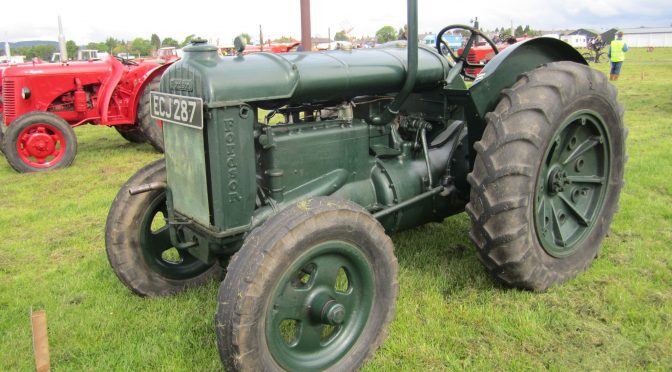Earlier in the week we started to look at the exhibition of agricultural implements at the Dumfries Show of the Highland Society from 1830 to 1910. Today, we will look at some of the implements and machines exhibited at that show.
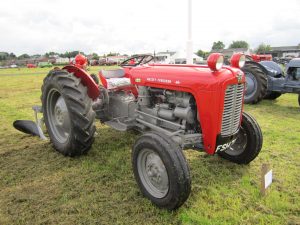
The wide range of implements and machines exhibited at the Dumfries show were sometimes described in detail in reports on the show in the provincial newspapers and the agricultural press. In 1895 the North British Agriculturist commented that James Gordon had ‘an immense variety of ploughs, harrows, mowers, binders, weighing machines, measurers, grinding mills, chaff cutters, meat coolers, corn bins, and churns; in fact almost everything that is wanted on a well-appointed farm.’ Others had a more limited range, or only one type of implement or machine. For example, in 1860 Peter Anderson, Innermessan, Stranraer, had a two horse plough for general purposes.
The implement and machine makers had a range of trades that shaped their manufactures. The largest makers, usually located in foundries, manufactured a range of implements and machines from metal. They included ploughs, implements to prepare the seed bed, sowing machines (having both metal and wood), horse hoes, hay rakes, potato raisers, turnip cutters, sheep fodder racks, feeding troughs, barrows and field gates. Carts were made by general implement makers as well as specialist cartwrights. Other specialist activities included the making of dairy utensils and machinery, threshing mills and a range of barn machinery, including fanners and bruisers, which were made by makers with specific trades. For example, William James Kelly, Dumfries, who exhibited dairy implements at the 1910 show was in 1912 a dairy utensil manufacturer, ironmonger, and a tinplate worker and brazier. Thomas Turnbull, Dumfries, who exhibited a range of implements between 1870 and 1910, including threshing machines, was a millwright as well as a mechanical engineer, engineer and ironfounder and agricultural implement maker.
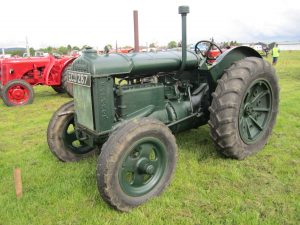
The exhibitors from the Dumfries show district largely focused on the manufacturing of implements and machines for specific tasks, especially ploughing, cultivating, sowing, and food processing and dairying. This focus is not surprising given the focus of the agriculture of south-west of Scotland on the rearing of livestock and dairying. They therefore manufactured (and exhibited) implements and machines that met the local needs of the farmer and agriculturist. Indeed, there were particular implements and designs of them associated with the region. For example, in 1895 Gavin Callander exhibited ‘two heavy grubbers of the Dumfries pattern’.
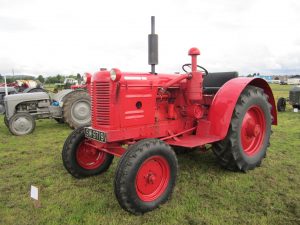
There was a distinct relationship between the Dumfries-shire made implements and machines and the county and region they were used in. Some makers expressed this through the trade names of their manufactures. Thomas Turnbull manufactured his ‘Dumfries’ broadcast sower for grain and grass from 1870. James B. A. McKinnell, Dumfries, had a ‘Dumfries’ grubber in 1878. Gordon & Coltart had a two and three horse ‘Dumfries’ grubber and ‘Galloway’ turnip cutter in 1886. In 1910, Eric Nicholson, Annan, made the ‘Annan’ oil engine in a series of four patterns.An important aspect of implement and machine making by exhibitors in the Dumfries show district was the manufacturing of turnip sowers. An analysis of the show catalogues (or Catalogue of Implements, Machines, and Other Articles) for the eight Dumfries shows between 1845 and 1910 reveals that they were exhibited by a total of 91 exhibitors. Those from the Dumfries show district were well represented, though their numbers fluctuated between shows; they had the smallest presence at the 1910 show. Of the 22 exhibitors from that show district, 19 exhibited a turnip sower at one show, while a further two did so at two shows; one exhibited at three shows. Before 1878 all of them exhibited machines that they had made. After that date six of them exhibited ones from other makers: in 1878 James Gordon and James Payne both exhibited machines from G. W. Murray & Co., Banff Foundry, Banff. Some exhibited machines made by local makers. In 1895 and 1910 Gavin Callander, Dumfries, exhibited a machine from James Gordon, Castle Douglas, as did Thomas Turnbull in 1910. In 1910 John Charlton & Sons, Dumfries, had one from Lillie & Co., Berwick on Tweed.
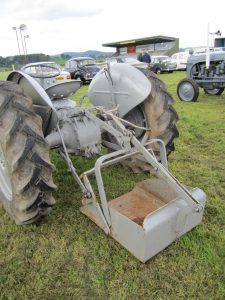
Another area of importance for a number of the implement and machine makers in the Dumfries show district was the making of dairy utensils and machines. They were included on 59 stands at 8 shows between 1845 and 1910. They comprised a wide range of utensils and machines, such as churning machines, curd mills, curd cutters, curd makers, milk pans, milk stirrers, milking pails, milk ripeners, milk coolers, milk cans, butter workers, butter churns (end over end, barrel, disc), whey drainers, cheese vats, cheese presses, refrigerators, measuring cans, and sundry small dairy utensils. The number of stands with them varied greatly from show to show. With the exception of the 1870 show, the Dumfries show district always supplied exhibitors of them to the Dumfries show. Most of these exhibitors exhibited at only one show, though John H. Ferguson, did so at two and John Gray, Stranraer, at three. By 1886 John Gray was ‘well known in the south of Scotland as a manufacturer of dairy requirements’. Most of them made their own utensils though some, including John McKerlie, exhibited ones made by other manufacturers such as D. Noble, Stranraer. In 1878 James Payne sold cheese presses from J. & T. Young, Ayr, a curd cutter from A. Pollock, Mauchline, Ayrshire, and barrel churns from R. Tinkler & Co., Penrith; all were leading makers. In 1910 Robert Armstrong exhibited sundry small dairy utensils and acted as an agent for one of the well-known English dairy and refrigerator makers, R. A. Lister & Co., Dursley.
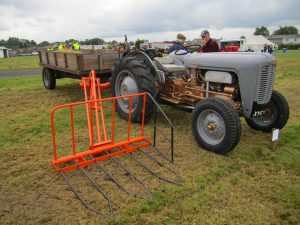
The manufactures of the implement and machine makers in the Dumfries show district did not provide the full range of implements and machines that were required by the farmer and agriculturist in that show district. Especially as agriculture became increasingly mechanized from the mid nineteenth century onwards, these makers together with other businesses, such as ironmongers, were also selling a range of other implements and machines made by other manufacturers in order to provide a comprehensive range to the farmer and the agriculturist. They were able to become agents for some of the leading makers in England and America, and in doing so, introduced new technologies into the show district, such as chilled ploughs and reapers and mowers.
In 1895 the Glasgow herald summed up the character of the exhibitors in the implement yard of the Highland Show at Dumfries. It stated that:
“Although there are not many manufacturers in the immediate vicinity, makers in all parts of Scotland and England find it to their advantage to exhibit at Dumfries. In this respect its proximity to the Border is a further inducement to Southern firms to place their manufacturers on view.”
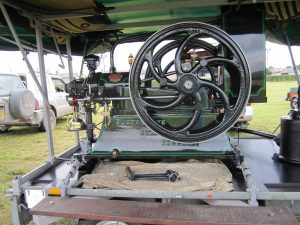
The character of the show districts and the geography of the show districts from one another, observed in relation to the Dumfries show district, was also noted in relation to the other show districts throughout Scotland. Large numbers of exhibitors from the Glasgow and Edinburgh show districts were found in their home show districts. For example, in 1882, some 74 of the 201 exhibitors at the Glasgow show were from that show district, while at the Edinburgh Show of 1899 some 24 of the 221 exhibitors were also from that show district. In 1893 some 34 of the 196 exhibitors at the Edinburgh show were from that show district. Other rural districts, notably Stirling, Inverness and Kelso, provided smaller numbers of exhibitors to their home show districts. For example, at the 1883 show at Inverness, some 17 of the 105 exhibitors were from that show district. At the 1900 Stirling show, 18 of the 176 exhibitors were from that show district. Geography was also an important factor for exhibitors from other show districts attending shows. For example, there were small numbers of exhibitors from both Edinburgh and Glasgow at the Inverness show in 1883 and 1911. There were also few exhibitors from Aberdeen at both the Kelso and Dumfries shows. Therefore, the Dumfries show reflected a number of wider patterns of exhibition that were also found in the other show districts.
The Scottish exhibitors were augmented by a growing number of ones from England, especially from 1870 onwards, though their numbers fluctuated from show to show. In Dumfries their number was higher than in most of the other show districts. As one observer noted, Dumfries was, ‘considering its situation and accessibility to implement makers on both sides of the Border’ an ‘attractive show location’. The number of English exhibitors was generally lowest in Inverness and Aberdeen, furthest from the Scottish Border and highest at the most important Scottish shows, Edinburgh and Glasgow, as well as those on the Scottish border.
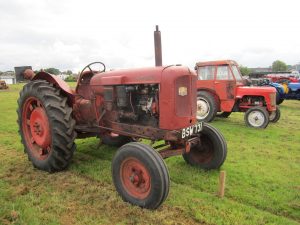
While the exhibitors from the Dumfries Show District did not themselves manufacture all of the agricultural implements and machines used by farmers and agriculturists in that show district, they made an important contribution in making particular types of them while also selling ones from other makers throughout Scotland and further afield. An examination of the implements and machines exhibited at the Dumfries Show in 1886 shows the place occupied by these exhibitors in the supply of implements and machines in the Dumfries show district. The implements on the 130 stands (24 were held by exhibitors from the Dumfries show district and a further 64 from England could be classified into 71 different categories or types. Some of these were small, with only one or two exhibitors, though others had large numbers. For example, there were 15 exhibitors of steam engines, 16 exhibitors of root pulpers, slicers and cutters, or the 17 exhibitors of ploughs.
The exhibitors from the Dumfries show district exhibited implements and machines in 45 of the 71 categories. Those from the other show districts in Scotland were represented in 56 categories, while those from England were recorded in 46 of them.
The exhibitors from these three provenances – the Dumfries show district, the rest of Scotland, and England – played a number of roles in exhibiting their implements and machines. Some were the only exhibitors of particular types or categories of implements and machines. For example, there was one such exhibitor from the Dumfries show district, 10 for the rest of Scotland and 8 from England. The Dumfries exhibitor specialized in cream separators while the Scottish exhibitors did so in potato planters, rakes for attaching to reapers, rick and stack stands, hay or rick lifters, hay and straw barrows, hay loaders, saddle harrows, turnip thinners and water barrows. The English makers specialized in bone crushers and mills, butter washers and coolers, root washers, horse hoes, scythes, stone breakers, straw trussers, and traction and locomotive engines. The English makers were were-renowned for making these manufactures, and for which there were no makers in Scotland.
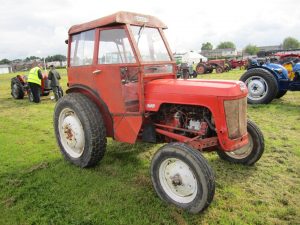
The character of the Dumfries show and the exhibitors of implements and machines was shaped by a number of factors. The first was the character of the Dumfries and Galloway region as a rural area with a focus on the rearing of livestock and dairying (before 1900 the show had strong exhibitions of Galloway cattle, there were only small displays of Aberdeen Angus and Shorthorns; it was the home district of the Ayrshire cow). As a rural area, it had a relatively modest manufacturing base, also reflected in the number of agricultural implement and machine makers, whose numbers were much smaller by comparison to other areas of Scotland, especially the Glasgow show district, with its heavy industries. Because of its location, close to the Scottish-English border, it was an important show district for the attendance of English agricultural implement and machine makers; their number was larger than in most of the other show districts, especially from the 1870s onwards.
As a result of these factors, the Dumfries show was characterized as having a small core of local exhibitors within the area of the show district augmented by significant numbers from other parts of Scotland and England. Two show districts each provided significant numbers, Glasgow and Edinburgh with the latter generally having half the number of the former district. The remaining districts in Scotland generally provided around twice the number of exhibitors to that of the Dumfries show district. Exhibitors from England comprised around three or four times the number of ones from the Dumfries show district. These exhibitors together with their exhibits, created a distinct show with its own character.
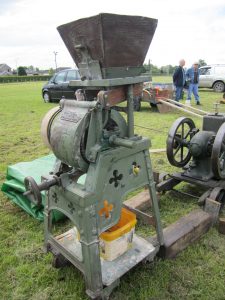
The exhibitors from the Dumfries show district ranged from small businesses to the most important agricultural implement and machine makers in the district. Some were renowned makers and were also well-known throughout Scotland, as also overseas where their manufactures were used. The basis of their exhibits were manufactures that reflected the character of the agriculture in the show district district. They included ploughs, cultivating implements and machines, turnip sowers and cutters, threshing machines, and dairy implements and machines. Their implements and machines were associated with the region through their trade names and the names of their makers. They were augmented by other manufactures from throughout Scotland and England, especially as agriculture became increasingly mechanized. The exhibitors from the Dumfries show district and their manufactures were therefore part, and a distinct part, of a wider tradition of agricultural implement and machine making throughout Scotland and also Britain, exhibited at the Highland Show.
The photographs were taken at the Dumfries vintage rally, 2014.
